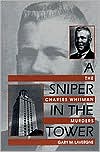A Sniper in the Tower: The Charles Whitman Murders
On August 1, 1966, Charles Whitman ascended the University of Texas Tower and committed what was then the largest simultaneous mass murder in American history. He gunned down forty-five people inside and around the Tower before he was killed by two Austin police officers. In addition to promoting the rise of S.W.A.T. teams to respond to future crises, the murders spawned debates over issues which still plague America today: domestic violence, child abuse, drug abuse, military indoctrination,...
Search in google:
The bodies kept falling, the blood was real, and the man on the deck, a consummate actor for a number of years, was no longer acting.On August 1, 1966, Charles Joseph Whitman ascended the University of Texas Tower and committed what was then the largest simultaneous mass murder in American history. He gunned down forty-five people inside and around the Tower before he was killed by two Austin police officers. During the previous evening he had killed his wife and mother, bringing the total to sixteen people dead and at least thirty-one wounded. The murders spawned debates over issues which still plague America today: domestic violence, child abuse, drug abuse, military indoctrination, gun control, the insanity defense, and the delicate balance between civil liberties and public safety. Publishers Weekly Through painstaking research and exhaustive analysis, Lavergne recreates the tragic and gripping circumstances that led "all-American" 25-year-old Charles Whitman to gun down 45 people from the University of Texas Tower in 1966. Lavergne homes in on the workings of Whitman's mind, finding that despite his middle-class upbringing, piano lessons, his scouting accomplishments (Whitman was among the youngest Eagle Scouts in history) and his Marine training, Whitman was tormented by his competitive, dictatorial father. Drawing from news accounts, interviews and Whitman's own writings, Lavergne argues that Whitman didn't suddenly snap, as has been previously thought, but descended slowly into madness. He "became a killer," Lavergne concludes, "because he did not respect or admire himself." At times, Lavergne gets bogged down in his quest to have the last word on Whitman, as when he dwells on such minutiae as whether Whitman's slayer, Officer Ramiro Martinez, enjoyed a pork steak or "piece of meat," before being summoned to campus. But as the events of August 1, 1966, unfold, Lavergne's fastidious approach generates substantial tension. Lavergne doesn't claim, as others have, that authorities should have anticipated violence from Whitman, especially given his confession to a psychiatrist some weeks before his pillage that he had thoughts "about going up on the Tower with a deer rifle and shooting people." Instead, Lavergne argues that the failure to recognize the warning signs testifies to how, in a state of innocence, "a nation discovered mass murder." This is the first book-length study of Whitman, and given the thoroughness of Lavergne's work, it may well remain the only one. Photos and maps. (May)
\ Publishers Weekly - Publisher's Weekly\ Through painstaking research and exhaustive analysis, Lavergne recreates the tragic and gripping circumstances that led "all-American" 25-year-old Charles Whitman to gun down 45 people from the University of Texas Tower in 1966. Lavergne homes in on the workings of Whitman's mind, finding that despite his middle-class upbringing, piano lessons, his scouting accomplishments (Whitman was among the youngest Eagle Scouts in history) and his Marine training, Whitman was tormented by his competitive, dictatorial father. Drawing from news accounts, interviews and Whitman's own writings, Lavergne argues that Whitman didn't suddenly snap, as has been previously thought, but descended slowly into madness. He "became a killer," Lavergne concludes, "because he did not respect or admire himself." At times, Lavergne gets bogged down in his quest to have the last word on Whitman, as when he dwells on such minutiae as whether Whitman's slayer, Officer Ramiro Martinez, enjoyed a pork steak or "piece of meat," before being summoned to campus. But as the events of August 1, 1966, unfold, Lavergne's fastidious approach generates substantial tension. Lavergne doesn't claim, as others have, that authorities should have anticipated violence from Whitman, especially given his confession to a psychiatrist some weeks before his pillage that he had thoughts "about going up on the Tower with a deer rifle and shooting people." Instead, Lavergne argues that the failure to recognize the warning signs testifies to how, in a state of innocence, "a nation discovered mass murder." This is the first book-length study of Whitman, and given the thoroughness of Lavergne's work, it may well remain the only one. Photos and maps. (May)\ \ \ \ \ Library JournalIn the summer of 1966, America lost its innocence when two mass murders were committed. In Chicago Richard Speck murdered eight student nurses, and 19 days later, on August 1, Charles Whitman gunned down people from the tower at the University of Texas at Austin, killing 16 and wounding 31. Lavergne, director of admissions and guidance services of the College Board's Southwest Regional Office, attempts to answer this question by writing the first full historical analysis of the event. Using primary sources and photographs, the author has done an excellent job of describing Whitman's murdering rampage. Was it caused by his domineering father, a brain tumor found during an autopsy, or both of the above? Lavergne examines these explanations and others as to why Whitman committed such a terrible deed. A good choice for true-crime collections.Michael Sawyer, Clinton P.L., Iowa\ \








